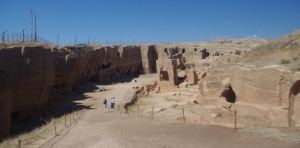 Dara site is located in the village of Oguz on the way to Nusaybin town, approximately 30 kilometers (19 miles) southeast of Mardin. Some say that its name derived from the legendary Persian king Darius. Others say that it was built in the beginning of the 6th century AD by the Byzantine emperor Anastasius as a castle on a strategic location against the Persians and used as a military garrison, and that it was known as Dara - Anastasiopolis. Historical events also mention that Alexander the Great captured the area in the 4th century BC. During its heydays in the Roman era Dara was also an important trade center and its population is estimated to be around 100 thousand. In the 7th century AD Arabs captured Dara and it lost its importance and thus abandoned. The Seljuk Turks dominated the land in the 15th century AD.
Dara site is located in the village of Oguz on the way to Nusaybin town, approximately 30 kilometers (19 miles) southeast of Mardin. Some say that its name derived from the legendary Persian king Darius. Others say that it was built in the beginning of the 6th century AD by the Byzantine emperor Anastasius as a castle on a strategic location against the Persians and used as a military garrison, and that it was known as Dara - Anastasiopolis. Historical events also mention that Alexander the Great captured the area in the 4th century BC. During its heydays in the Roman era Dara was also an important trade center and its population is estimated to be around 100 thousand. In the 7th century AD Arabs captured Dara and it lost its importance and thus abandoned. The Seljuk Turks dominated the land in the 15th century AD.
The excavations here started in 1986 and there is still lots to excavate. When you visit Dara you can see the huge underground water cisterns once supplying water to the castle, an extensive necropolis, an open-air theater, a bridge, the agora, military depots, barracks, houses, churches, an arch dam, and other monumental structures mainly carved into the rocks and scattered around a large area. The citadel is located on a hill higher than the city. The city walls were 20 meters high and approximately 4 kilometers long and there were two gates; one in the south and one in the north, all of them are in ruins today. The most impressive part of Dara is the cisterns which were also noted as dungeons by the village people, meanwhile the rest of the site is hard to visit.

